Every recovering alcoholic or addict knows that each day of sobriety is a reprieve from active addiction. Active addiction is a chronic illness that may ultimately kill you. If you are an addict, you know that to drink or drug is to die.
Living life sober can be full of many challenges that can sometimes threaten sobriety. When faced with a diagnosis of terminal illness, the battle to stay clean and sober, no matter what, intensifies.
Personal Story Of John Eggers’ Terminal Illness Positively Redefining His Life
John Eggers, a 48-year-old attorney from Irvine, CA was diagnosed with glioblastoma, an aggressive form of brain cancer. There is no cure for his cancer, and the prognosis is poor. Without treatment, he would have approximately three months to live. With treatment, doctors predict his remaining life expectancy is 12 to 15 months. Experts say that less than 10 percent of glioblastoma patients survive five years after diagnosis.
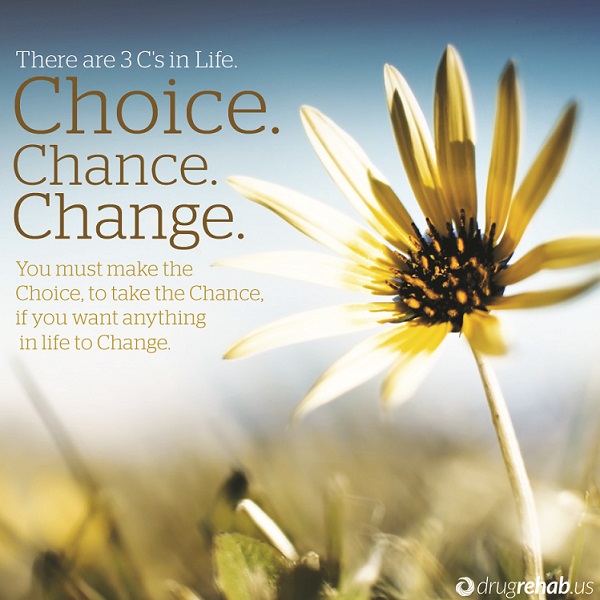 His symptoms came on suddenly one day after a trip to the gym. He lost feeling in his limbs and couldn’t speak. He suffered a seizure. A brain tumor was discovered, and he learned that he had a terminal form of cancer.
His symptoms came on suddenly one day after a trip to the gym. He lost feeling in his limbs and couldn’t speak. He suffered a seizure. A brain tumor was discovered, and he learned that he had a terminal form of cancer.
Eggers has been video blogging his final months of life for KTLA while he shares his experiences and checks things off his bucket list. Some of the items he has already been able to do include meeting Vice President Joe Biden, traveling to Europe and skydiving. He has also appeared on a TV show and met his favorite band, Depeche Mode. Living with terminal illness, Eggers is redefining his life.
Eggers admits that before his illness, he led a life driven by self-centeredness and not much regard for others. Faced with his own death, that has all changed. John has raised funds for families of others with cancer, and he has worked pro bono to help families of sick children stand up to insurance companies.
Trying To Escape Reality Through Opiate Addiction
Recently he was given opiates for pain but began abusing them to cope with depression and anxiety. Not many people would blame a dying man for wanting to escape from reality. But if you’re in recovery, you know that abusing drugs doesn’t make problems go away. It only postpones them or creates new ones.
In a recent video blog, he stated, “My name is John Eggers and I am a drug addict.” John decided to check into a treatment facility to beat his addiction, because he knew the drugs could kill him before the cancer did. As he pursues a life free of drugs, John hopes to be a powerful example to other addicts who are battling cancer.
And he wants to die drug-free.
Choosing Sobriety No Matter What
Eggers describes his addiction as “a very dark place,” a place beyond the comprehension of most people. He says the fact that his lifespan is short is acceptable to him, but that what isn’t acceptable is wasting any more of the time he has left on opiates or other drugs.
Newly out of treatment, Eggers continues to document his journey and his struggles. One side of his face is paralyzed since brain surgery, and at times he has difficulty choosing words as he speaks. But his desire to be clean and sober is unwavering.
The natural reaction for a drug addict or alcoholic when faced with extreme stress is to turn to chemicals, and there isn’t much greater stress than being faced with your own death. If you’re an addict, turning to mind-altering substances is not bad behavior. It’s doing what comes naturally. But it’s possible to recover from addiction to drugs, and John is making that choice today. Choosing recovery is making a conscious choice to go against the natural urge to use and abuse drugs and alcohol. No matter what.
In the case of John Eggers, he is choosing sobriety in spite of a death sentence, and he is using his final days to carry the message of a drug-free life. He hopes to inspire others through his video blog. If he can stay sober while he is facing a great deal of pain and his own mortality while he journeys through the dying process, others can stay sober too—no matter what they are facing.
YOU CAN DO THIS!
Most people recovering from an addiction to an opioid drug or medication will experience a relapse fairly early in the treatment process. Two key factors in the onset of a relapse are the presence of continuing cravings or urges for opioid use and the onset of withdrawal symptoms after initial opioid detoxification.
In a study slated for publication in February 2015 in the journal Addictive Behaviors, a team of American researchers looked at the ways in which cravings and withdrawal symptoms impact the relapse risks for any given person recovering from prescription opioid addiction.
Opioid Cravings
All people dealing with opioid drug or medication addiction have longstanding chemical changes in their brain function that make them physically dependent on the continued intake of some form of opioid substance.
 Opioid cravings are essentially unconscious and conscious signals sent by the brain as a reminder of the established need to maintain at least a minimum level of opioid intake. Conscious cravings may manifest as clearly articulated thoughts supporting immediate opioid consumption or opioid consumption in the near future.
Opioid cravings are essentially unconscious and conscious signals sent by the brain as a reminder of the established need to maintain at least a minimum level of opioid intake. Conscious cravings may manifest as clearly articulated thoughts supporting immediate opioid consumption or opioid consumption in the near future.
Conversely, unconscious cravings may manifest as unarticulated urges for opioid intake. Conscious and unconscious cravings for the use of opioids or any other substance commonly stem from exposure to drug cues.
These cues are reminders of the actions commonly undertaken during episodes of substance use, the thoughts or feelings associated with substance use or the circumstances in which substance use typically occurs.
A strong drug cue can support a rapid escalation of drug cravings, and thereby steeply boost the short-term odds of drug use. The presence of opioid cravings is a diagnosable symptom of opioid use disorder (opioid abuse/addiction).
Opioid Withdrawal
Withdrawal is a second reinforcer used by the dependent/addicted brain to ensure the continued consumption of any given substance. It occurs when the levels of that substance fall below the levels required by the currently established conditions of addiction.
Opioid Withdrawal Symptoms
Specific symptoms of opioid withdrawal include:
- sleeplessness
- achy muscles
- an unusually anxious or agitated mental state
- excessive sweat production
- nausea
- vomiting
- pupil dilation
- diarrhea
- cramping in the stomach or abdomen
Unlike some forms of withdrawal (e.g., alcohol withdrawal), opioid withdrawal has no potential to trigger fatal changes in body function. However, affected individuals commonly feel uncomfortable enough to resume opioid intake. Withdrawal symptoms are usually most prominent during initial opioid detoxification. Along with opioid cravings and a range of other symptoms, doctors use the presence of withdrawal symptoms to help diagnose the presence of opioid use disorder.
Impact On Opioid Relapse Rates statistics
In the study scheduled for publication in Addictive Behaviors, researchers from the University of Texas Medical School at Houston, the University of Texas Health Science Center, the University of Texas Southwestern Medical Center and Harvard-affiliated McLean Hospital used information from a project called the Prescription Opioid Addiction Treatment Study to help determine exactly how opioid cravings and opioid withdrawal work together to increase the odds that any given person in recovery will relapse back into uncontrolled opioid use.
A total of 653 people dependent on or addicted to opioid medications took part in the study. All of these people received a commonly used medication, called buprenorphine/naloxone, that’s specifically designed to reduce the risks for relapse in people affected by opioid addiction.
The researchers concluded that there were four distinct groups of people in the larger pool of study participants: people with high levels of opioid craving and opioid withdrawal, people with moderate or intermediate levels of opioid craving and opioid withdrawal, people who transitioned from high levels of craving and withdrawal to low levels of craving and withdrawal, and people who maintained low levels of craving and withdrawal.
The researchers also concluded that three groups of participants were least likely to relapse back into uncontrolled opioid use: people who experienced a reduction in their craving and withdrawal levels over time, people who initially experienced low levels of craving and withdrawal, and people who responded well to the craving- and withdrawal-reducing effects of buprenorphine/naloxone.
The study’s authors believe that their work increases the level of understanding about those individuals most likely to rapidly relapse after entering treatment for prescription opioid dependence/addiction. They also believe that their work underscores the importance of paying close attention to changing craving and withdrawal symptoms during the recovery process.
Finally, the authors believe their work may increase the future ability to identify individualized treatment patterns that decrease each affected person’s chances of experiencing an early opioid relapse.
No one would have ever expected anything but success out of Liam. He was born to a charmed, wealthy family and had been its shining jewel. An all-star athlete and honors student, he’d attended Stanford University School of Medicine, with every intention of becoming the neurosurgeon he vowed he’d become at only 17. But a skiing accident changed everything for Liam; he’d been accelerating down a black diamond when a less skilled skier collided with him, injuring his lumbar. The back pain and medical treatments, including two surgeries, entailed the use of opioid painkillers in order to get Liam through the day.
Without his steady hand and laser focus, or an ability to stand comfortably for hours on end, his dream of operating fell away. And without an ability to be active in the same ways he had been—Liam had been something of a fitness nut before his injuries—he grew depressed. Soon enough, he realized he’d developed a problem with his pain medication; he had become dependent.
When You Become Addicted To The Treatment
 Liam was still seeking a residency (he would be a neurologist rather than a neurosurgeon), and knew that an addiction could drastically complicate his hopes. He’d heard plenty about compromised doctors and nurses who’d been arrested while abusing hospital medications, or injuring patients while high. He didn’t want to become a shameful statistic. So he sought treatment through a private referral. He would take Suboxone, or buprenorphine, an opioid pain reliever also used for long-term treatment of opioid addiction.
Liam was still seeking a residency (he would be a neurologist rather than a neurosurgeon), and knew that an addiction could drastically complicate his hopes. He’d heard plenty about compromised doctors and nurses who’d been arrested while abusing hospital medications, or injuring patients while high. He didn’t want to become a shameful statistic. So he sought treatment through a private referral. He would take Suboxone, or buprenorphine, an opioid pain reliever also used for long-term treatment of opioid addiction.
In the beginning, the buprenorphine worked well, but Liam discovered that the benzodiazepine he’d been prescribed for anxiety relating to his crash and the stress it had caused, when combined with the Suboxone, created something of a high. His habit-seeking behaviors began again in earnest. The Suboxone was no longer serving him as treatment for dependence. He was addicted to the treatment itself.
Opioid Addicts In Need Of Treatment
Buprenorphine, sold as Suboxone or Subutex, was approved by the FDA in 2002 for the treatment of opioid addiction in the U.S. Buprenorphine is prescribed by limited approved doctors as a sublingual (under-the-tongue) treatment for moderate pain and for long-term treatment of opioid addiction to suppress the symptoms of withdrawal and to reduce cravings. While it does not cause euphoria in opioid-dependent patients (and blocks the effects of other opioids for at least 24 hours), it can create euphoria and subsequent dependence in individuals who are not previously dependent on opioids. And while it is considered safer than methadone treatment, individual users still find ways to achieve a high (with combination benzodiazepines in some instances), making them more likely to remain drug dependent and less likely to recover.
From a New York Times piece in November, 2013: “Suboxone is the blockbuster drug most people have never heard of. Surpassing well-known medications like Viagra and Adderall, it generated $1.55 billion in United States sales last year, its success fueled by an exploding opioid abuse epidemic and the embrace of federal officials who helped finance its development and promoted it as a safer, less stigmatized alternative to methadone.”
Questioning Safety With Suboxone
In the realm of addiction, there are (many) dragons. Buprenorphine may, in fact, be doing more good than harm, and until statistical evidence reveals otherwise, a story like Liam’s may be purely anecdotal. There are others like him, but their numbers may stack up only so high compared to the numbers of individuals who are being helped by treatments like Suboxone. Opioids, it appears, create one of the hardest addictions to quit, and those who suffer may need all the help they can get.
Still, it’s wise to bear in mind that crossover addiction—the exchange of one addiction for another—is nearly universal in the addiction community. If an addict drops one addiction, he picks up another. With maintenance treatments like methadone and buprenorphine, the crossover addiction may become a case of choosing between the lesser of evils—and surely Suboxone treatment is a lesser evil than previous painkiller addictions.
If You Are Struggling With Opioid Abuse Or Addiction, It’s Time To Step Up And Make The Call…It Could Change Your Life!
OxyContin is the brand name of an extended-release painkilling medication that contains the opioid narcotic substance called oxycodone. In its original form, this medication was easy to tamper with and use as a source of opioid abuse. In response to this situation, the manufacturers of OxyContin reformulated the medication and made it considerably more tamper-resistant.
In a study published in June 2014 in the journal Drug and Alcohol Dependence, a team of U.S. researchers investigated whether the reformulation of OxyContin has had the desired effect of reducing the number of people who use the medication in a pattern of opioid abuse.
Oxycodone And OxyContin
Oxycodone is a generic opioid medication noted for its usefulness in the relief of various forms of serious or severe pain. Like all other opioid drugs and medications, it can trigger diagnosable problems with abuse or addiction when used in ways not sanctioned and monitored by a doctor. Some branded medications contain oxycodone in combination with other, less-powerful painkilling substances such as acetaminophen, aspirin or ibuprofen.
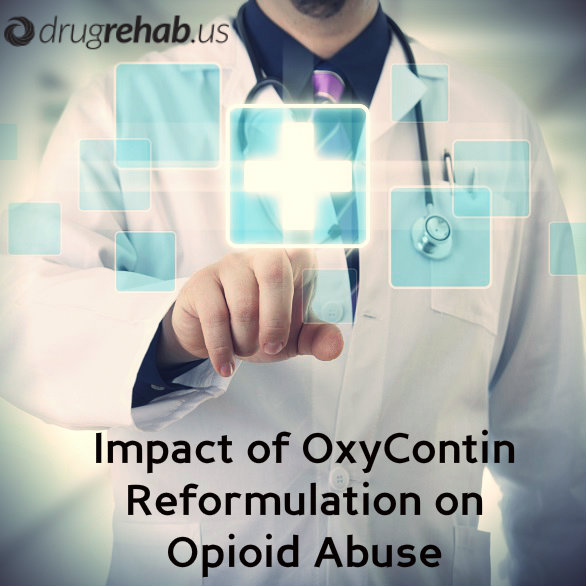 Common examples of these combined medications include Percocet, Endocet, Percodan, Combunox and Roxicet. Other branded medications contain only oxycodone as their active ingredient. In addition to OxyContin, examples of these medications include Oxecta and Roxicodone.
Common examples of these combined medications include Percocet, Endocet, Percodan, Combunox and Roxicet. Other branded medications contain only oxycodone as their active ingredient. In addition to OxyContin, examples of these medications include Oxecta and Roxicodone.
OxyContin arrived on the U.S. market in 1995. It is specifically designed to provide extended amounts of pain relief to people affected by ongoing moderate or severe pain. Since it must produce its effects for many hours, an OxyContin tablet contains more oxycodone than most other available medications.
Unfortunately, in its original form, the medication was highly susceptible to crushing, chewing, dissolving and other forms of manipulation that made its oxycodone content available all at once. This fact made OxyContin a prominent target for abuse by people seeking the recreational drug effects of opioid intake. Widespread availability of the medication also contributed to its prominent role in opioid abuse in the U.S.
OxyContin Medication Reformulation
Along with addiction specialists, public health officials and drug enforcement officials, the manufacturers of OxyContin (Purdue Pharma LP) became well aware of the role that abuse of the medication played in the larger phenomenon of prescription opioid abuse.
In response, they withdrew the original formulation of OxyContin from the market and, in August 2010, released a new version of the medication that is substantially harder to use as a source of abuse. Specific steps taken during this reformulation include minimizing the availability of oxycodone even after crushing or other manipulation occurs, as well as making it impossible to pass a dissolved form of the medication through a syringe for injection.
Impact Of OxyContin Reformulation On Opioid Abuse
In the study published in Drug and Alcohol Dependence, researchers from the University of Kentucky and Purdue Pharma used interviews with a group of 189 adults with a prior history of abusing OxyContin to assess the effectiveness of the new formulation of the medication in discouraging opioid abuse. During these interviews, each participant was asked to compare their monthly level of involvement in opioid abuse before the OxyContin reformulation to their monthly level of involvement after the reformulation.
After analyzing the results of the interviews, the researchers found that 33 percent of the participants had tried to abuse the reformulated version of OxyContin in the month before the study. This contrasted with a 74 percent rate of monthly OxyContin abuse prior to the reformulation, as well as with a 96 percent rate of monthly abuse for any form of immediate-release oxycodone.
Individual rates for snorting and injecting the reformulated medication were also substantially lower than the snorting and injection rates associated with both the old version of OxyContin and oxycodone products that release immediately into the bloodstream. Overall, the study participants tried to abuse the reformulated OxyContin on roughly two out of 30 days. In contrast, abuse of the original version of the medication took place approximately 13 days a month, while abuse of immediate-release oxycodone took place about 20 days a month.
The researchers note that abuse of the old version of OxyContin among the study participants became much less common after the new version of the medication reached the market. In addition, they note that the participants rarely shifted from oxycodone abuse to heroin use. All told, they concluded that, at least among the people who took part in the study, the new version of OxyContin does not play the same prominent role in opioid abuse as the original version of the medication first released in the 1990s.
Do You Or Someone You Know Need Help With Prescription Drug Addiction?
Call Us Now! Help is Available 24/7!
11 Nov 2014
5 Facts About Veterans And Substance Abuse
Veterans Day is a time to remember and celebrate the people who have made sacrifices to serve in the military. If you have a veteran in your life, you know the toll that service can take. Mental health issues, including substance abuse, are common among men and women who have seen combat overseas. We should all recognize this struggle and be more aware of the issue. With awareness comes understanding, compassion and real change.
Facts About Veterans And Substance Abuse
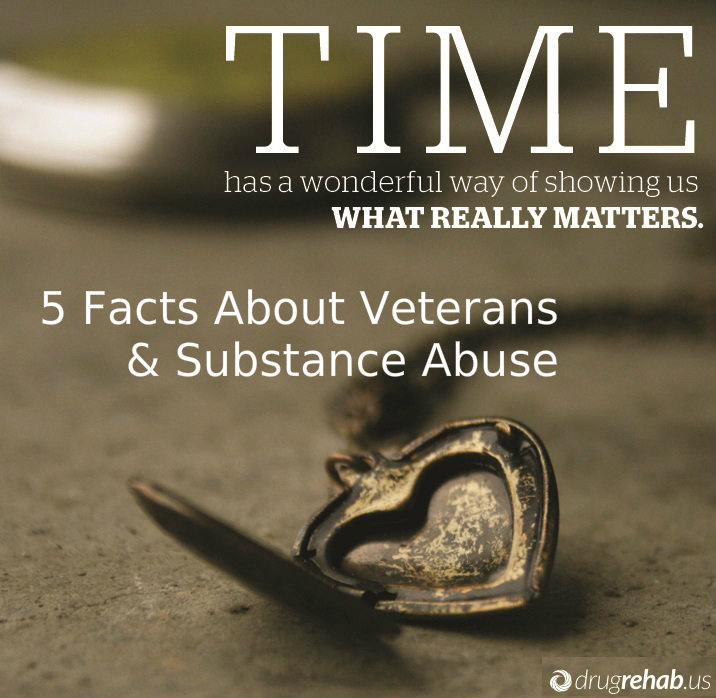 1. Prescription Abuse Among Vets On The Rise
1. Prescription Abuse Among Vets On The Rise
Use of illicit drugs by active military personnel is quite low. Compared to civilians, men and women in the military rarely use illegal drugs because of strict policies and enforcement by random drug testing.
On the other hand, prescription drug abuse is a real problem for both active duty military personnel and veterans. The rate of misuse of prescriptions increased from 2 percent in 2002 to 4 percent in 2005 and 11 percent in 2008.
2. Veterans Have A Drinking Problem
Alcohol may be legal, but it is a substance of abuse for many people and veterans are no exception. The Armed Forces Health Surveillance Center says that one in eight troops get streatment for alcohol abuse after returning from overseas deployment. While women are not immune from the problem of drinking, men are the ones who are really struggling. Twenty three percent of male veterans binge drink, compared to 14 percent of female veterans.
3. Substance Abuse And Veteran Suicides
For most of modern military history, suicide rates have been lower for troops and veterans than for civilians. Starting in 2004, though, the incidents of suicide in the military have been rising. In 2008, the rate of suicides in the military surpassed the rate among civilians. Substance abuse is often involved in cases of suicides. According to the Army Suicide Prevention Task Force, one-third of suicides included abuse of prescription drugs.
4. PTSD Is Linked to Substance Abuse
Post-traumatic stress disorder, or PTSD, is a common mental health issue for veterans. The experiences of combat haunt military personnel — some develop the flashbacks, panic attacks, nightmares and other symptoms that characterize PTSD. Many turn to drugs or alcohol as a form of self-medication. Nearly a quarter of veterans with PTSD will also develop a substance abuse problem, and one-third of those seeking treatment for substance abuse also have PTSD.
5. Treatment Is Available For Vets
If you are a veteran and you struggle with drug or alcohol use, or you care about a vet who is having a problem, know that help is available. The Department of Veterans Affairs offers several services for vets, including screening and diagnosis. This first step can even be done anonymously. The veteran can then decide to take steps to get treatment. Options for treatment are varied and include therapy, couples and family counseling, support groups, care for a dual diagnosis of mental illness and substance abuse, and medication. The VA offers residential treatment as well as outpatient care and continuing care.
Substance abuse is a common problem among veterans because of the experiences of active duty. Mental health care is crucial to these important people and they deserve to have the best treatment modern medicine can offer.
If you or someone you care about is struggling with drinking, drugs or mental illnesses like PTSD, contact the VA and find out how to get access to treatment. It could save the life of the vet you love.
Now that you are an adult and your parents are older, it may become your responsibility to care of them. Even if they don’t need round-the-clock care, it is important that you make sure your parents are happy and healthy and living well.
Part of that means watching for signs of drug abuse and protecting them from the risk of getting hooked on drugs.
It may seem like a worry you should never have to consider, but the truth is that drug abuse among older Americans is on the rise. Here’s how you can protect your parents.
Protecting Your Parents From Addiction
Get Educated
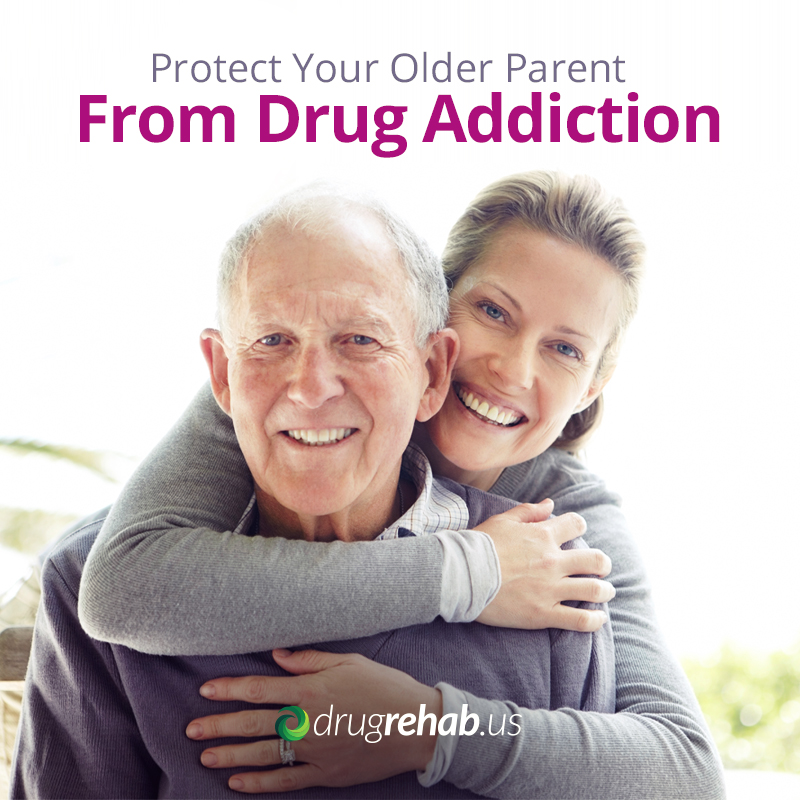 To protect parents from the dangers of substance abuse, it’s important that you understand the issue. Educate yourself about senior substance abuse and addiction so you are aware of the risks and the signs. Although it’s surprising, substance abuse among seniors is not that unusual. In fact, it is a growing phenomenon. Estimates show that by 2020, the number of older Americans needing treatment for a substance use disorder will have doubled. Just a few years ago, nearly five percent of adults over 50 were abusing drugs or alcohol.
To protect parents from the dangers of substance abuse, it’s important that you understand the issue. Educate yourself about senior substance abuse and addiction so you are aware of the risks and the signs. Although it’s surprising, substance abuse among seniors is not that unusual. In fact, it is a growing phenomenon. Estimates show that by 2020, the number of older Americans needing treatment for a substance use disorder will have doubled. Just a few years ago, nearly five percent of adults over 50 were abusing drugs or alcohol.
There are several reasons older Americans are susceptible to substance abuse. One is access to prescriptions. Nearly one-third of prescriptions in the U.S. are written to people over 50. Becoming dependent on habit-forming prescriptions is more likely the more they are prescribed. Seniors are also more likely than younger people to experience certain social factors that may contribute to substance abuse: social isolation, a feeling of uselessness after retirement, the loss of a spouse, and depression.
Talk About Drug Abuse
Armed with the facts, start a discussion with your parents. It may be awkward or uncomfortable at first, but knowledge is power. If you can make your parents understand how risky it can be to abuse their prescriptions or to drink too much, they will likely make better decisions. They may also be unaware just how their emotional health impacts the choices they make regarding substances. Encourage your parents to get involved in social activities and to talk to you if they are feeling lonely, depressed or sad.
Help Manage Prescriptions
Abuse of prescriptions by seniors is often unintentional. Many get hooked simply because they need a drug, like a painkiller, to feel better and then use of it spirals out of control. With many different prescriptions, which is common with seniors, it can get confusing. Your parents may end up making mistakes with doses and combinations. Go to appointments with your parents and take careful notes about medications, dosages and interactions. Help your parents organize medications and monitor their drugs to be sure they are taking them correctly.
Monitor Behaviors And Get Help
Drug abuse has telltale signs, no matter the age of the user. Spend time with your elderly parents and watch for changes in health or behaviors that trouble you. Drug or alcohol abuse can cause changes in sleeping habits or appetite, irritability or anxiousness, confusion, and an increased number of falls. You know your parents, and if anything changes that makes you uncomfortable, be suspicious.
If you do suspect substance abuse in a parent, don’t hesitate to get help. Treatment options are available and seniors are more open to them than you might think. The good news is that statistics show that patients over 50 are the most successful when it comes to getting addiction treatment. Be there for your parents, guide them, educate them and help them when they need it so that you will have many more years to enjoy spending time together.
Get The Know-How On Why Substance Abuse Is Rising Among Seniors
07 Oct 2014
Protecting Older Loved Ones From Substance Abuse
When you take care of your aging parents you are paying back all the years of love and care they took in raising you. You are also doing something out of love. You care for your parents and want them to be safe and comfortable as they age. Whether or not an older parent lives with you, you hope to be an advocate, a caregiver and someone on whom they can rely. What you probably never thought you would have to worry about is substance abuse. Statistics show that older Americans are abusing drugs more than in any previous generation. How do you know if your mom or dad is taking part in this trend and how do you prevent it?
Substance Abuse In Older Americans
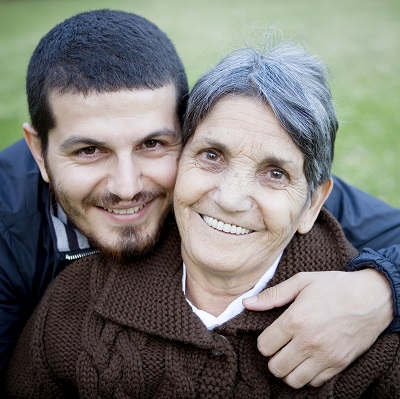 It may seem unlikely, but substance abuse is a real problem in the aging population today. If you have a parent to care for, you should be aware of the issue.
It may seem unlikely, but substance abuse is a real problem in the aging population today. If you have a parent to care for, you should be aware of the issue.
Senior Prescription Drug Abuse
Thirty percent of older Americans take at least five different prescription medications every day, which means they have numerous opportunities to abuse prescription drugs. Abuse of prescriptions is one of the biggest substance abuse problems among the older population. Hospitalization of older patients for prescription-related problems rose nearly 100 percent over a decade from 1997 to 2008.
Senior Alcohol Abuse
The other major type of substance abuse among older adults is alcohol. Access and habit can help to explain why older adults abuse prescriptions and alcohol. Many older people grew up at a time when drinking a cocktail after work every day was considered normal behavior. Depending on the population studied, between 3 and 25 percent of older Americans drink heavily. A particular concern is the combination of alcohol and prescription drugs.
Protect Your Parents From Substance Abuse And Addiction
It is important to understand that there is an issue when it comes to older Americans and substance abuse. You should also understand what makes older adults susceptible to abuse and addiction so that you can protect your parents and any other older loved ones. One reason they may become hooked on drugs is the prevalence of prescriptions. Older people are often prescribed medications, such as painkillers, which are highly addictive. With pain from arthritis, surgery or falls, older adults are more likely than younger people to be prescribed these painkillers.
Another issue with older people is loneliness. As we age our social circles begin to shrink. Many older adults find themselves more alone than ever before. Depression is also a problem as they lose friends or a spouse. Turning to drugs or alcohol to mitigate feelings of sadness, depression and loneliness is not uncommon.
To protect your parents from the possibility of substance abuse or even addiction, it is important that you counteract the factors that make them vulnerable. Monitor the prescriptions that your parents use and talk to their doctors about whether any of them can be abused or are addictive. If any of them are, talk to your parents about the possibility of getting addicted to them. Check with with doctor also to see if any can safely be switched over to a less-addictive prescription
Perhaps most importantly, spend time with your older loved ones. Changing social circumstances can make a powerful impact and you can make a difference. In addition to spending time with them, also encourage your parents to seek out social activities. Get them involved in senior centers where they can meet new people. An active social life, combined with your love and attention, will go a long way toward helping your parents feel good about life. These actions will also help protect them from the growing dangers of substance abuse.
Read More About: The Unimagined Costs Of Having An Addicted Family Member And What You Can Change – Healing Is Possible! Don’t Give Up!
Prescription painkillers can be useful medications to help you manage moderate and severe pain. In fact, for many people, these drugs make life tolerable again because they are so good at relieving pain. However, narcotic painkillers can also be dangerous. If you are prescribed an opioid narcotic painkiller, make sure you understand the risks and take steps to avoid becoming addicted.
Prescription Narcotics And The Addiction Epidemic
 Narcotic opioid painkillers include drugs that are found naturally in the opium poppy as well as substances that were invented in a lab based on these natural compounds. They work to relieve pain in the body by activating opioid receptors in the brain and other parts of the nervous system. This activation also gives the user a profound sense of euphoria, also known as a high. It is this effect that causes many people to abuse opioids and become addicted.
Narcotic opioid painkillers include drugs that are found naturally in the opium poppy as well as substances that were invented in a lab based on these natural compounds. They work to relieve pain in the body by activating opioid receptors in the brain and other parts of the nervous system. This activation also gives the user a profound sense of euphoria, also known as a high. It is this effect that causes many people to abuse opioids and become addicted.
The Centers for Disease Control and Prevention reports that by 2010 one in 20 Americans over the age of twelve had abused a narcotic painkiller. In 2008, these drugs caused nearly 15,000 overdose deaths, a number that had quadrupled in a decade. Risk factors for overdosing on narcotic painkillers include being a man, living in a rural area and being middle aged, but anyone can be vulnerable.
What To Do To Keep Yourself Safe When Taking Painkillers
Take Your Medications As Directed
The most important thing you can do to take your medications safely and avoid becoming addicted is to follow your doctor’s directions. Never take more than your recommended dose without asking your doctor first. Never take the medication more frequently than recommended and never take it for a longer period of time. Do not crush a medication. Some drugs include extended release formulations, which can be destroyed when crushed. Doing any of these things constitutes abuse of the drug and puts you at risk for dependency. If your medication is not adequately relieving your pain, speak to your doctor about changing your prescription or dosage.
Communicate With Your Doctor And Other Caregivers
Health care workers can only help patients to the extent that there is good communication. A good relationship between you and your doctor will give help you to get the best care possible. Tell your doctor if you experience any uncomfortable side effects from a prescription. Also report when a drug is not working for you or if its effectiveness has changed at all. It is also important that you tell your doctor about any other medications or supplements that you take. There may be dangerous interactions with your narcotic painkiller.
Stop Drinking
Narcotic painkillers interact dangerously with alcohol. Even one glass of wine or one cocktail while taking a prescription painkiller can be harmful. Both alcohol and your painkiller affect your central nervous system in such a way as to make you a little fuzzy. They both depress your breathing. When taken together, these effects are multiplied. Many overdose deaths occur when someone has mixed a painkiller with alcohol. As long as you need to be on this medication, avoid drinking at all.
Protecting yourself from the dangers of narcotic painkillers is important. If you follow these guidelines you can get the benefits of these drugs while minimizing your risk of dangerous side effects, addiction and overdosing. It is also important to protect those around you. Most people who abuse narcotic painkillers got them from a friend or family member. Never give your prescription to someone else and keep your medications locked up so that no one else can get access to them.
Read More About Drug Overdose Risks


